Page 1 of 1
Post-war replacement CCKW beds
Posted: Thu Dec 27, 2007 9:26 pm
by Hammerhead
On this board and others, there's been several references to post-war made CCKW beds especially in Europe. I know Germany was mentioned. Were any other countries involved? Were they mainly replacing the composition beds with steel beds? Were there distinquishing characteristics on the European beds or were they identical copies of the WWII production beds? I know some have said their replacement beds had tags from the facility it was produced at; was that a pretty universal practice? Anyone have an idea how widespread this was. Just curious since I have a "European Return" CCKW. I believe it has an original bed. Thanks, Hammerhead
German Replacement Cargo Bodies
Posted: Thu Dec 27, 2007 11:11 pm
by Cat Man
The German built postwar all steel replacement cargo beds are to the visual observer, identical to the early prewar all steel American ones.
Except in one area. The bottem of the stake pockets on each side are different. On the original American design, the pockets are a solid "box" at the bottem were they are welded to the bed sill. They have a drain hole under them that didn't drain and they rust out at the bottem. There was an MWO to cut an opening at the bottem of each stake pocket for additional drainage on trucks in service. This was done with a cutting torch and leaves a rough and usually jagged opening. (depending on the skill of the torch operator). I have an original bed behind the shed.
The German replacements were built with this feature included in each stake pocket. The half moon shaped opening at the bottem of each stake pocket is a smooth machine made radius. Easy to spot.
Remember that a wood body, requires more maintenance, absorbs water so they are heavy, they also absorb spilled fuel and oil if they haul 5 gal cans. A seasoned oak wood bed, soaked with fuel and oil over a few years is also a fire hazard. So the idea I'm sure was to replace the war time wood expedient bed with steel whenever possible.
There were also rebuild programs in Okinawa and Japan before Korea. Don't know if they also built new steel beds.
Here are some close ups of a German replacement bed. Note the opening in the bottem of the stake pocket on the right rear corner.
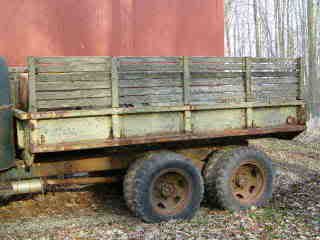
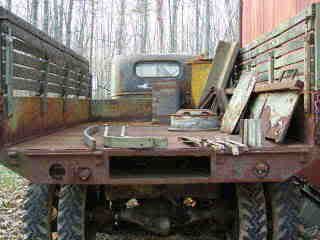
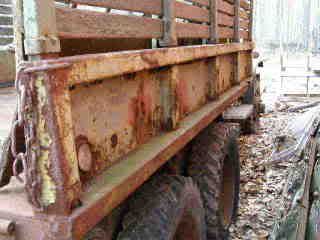
They are really made well (Hey, they are afterall German!) After blasting and painting, the pockets are the only way to tell the difference.
I can post some photo's of the original if you want to compare them.
Drive On!
Cat Man
Replacement Bed
Posted: Thu Dec 27, 2007 11:15 pm
by Cat Man
Opp's, close up photo didn't load.
Here it is

Cat Man
Posted: Fri Dec 28, 2007 9:37 am
by armydriver
Great photos Cat Man. I renjoyed reading your response to the question. Thanks.
Posted: Fri Dec 28, 2007 6:47 pm
by UK Jack
Just read this Cat Man and just went out side to check mine and it is exactly as you say - mine are indeed gas cut and man, the cutter must of been in a hurry

Perfect, great info!
Posted: Sat Dec 29, 2007 6:21 am
by Chris_M
Cat Man is perfectly right. My GMC has a german steel bed made by C.Blumhardt in Wuppertal. It has these haf moon shaped openings as you can clearly see:
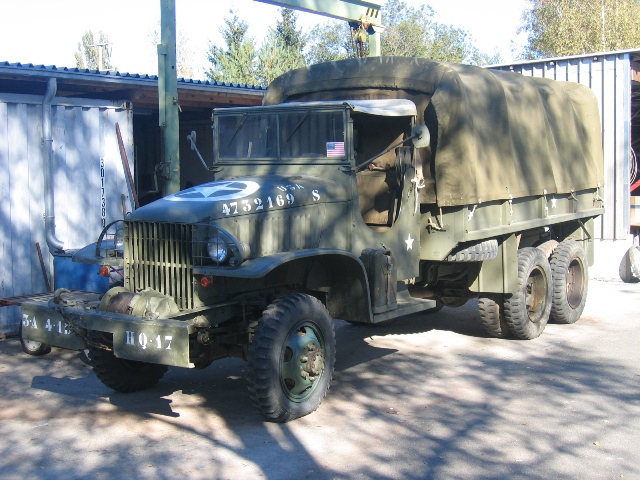
Posted: Sat Dec 29, 2007 11:47 am
by John V Cliche
What with the replacement of so many wooden beds with a lighter, more efficient material ,ie steel, certainly explains the rarity and desirability of the wooden bodied survivors

John
Posted: Mon Dec 31, 2007 12:50 am
by Hammerhead
Hello all,
Catman...Thanks for the great explanation and pictures. I always wondered if the bed on my truck was original or a post-war replacement. The truck was produced in April 1944 and was a "European return" from the Army of the Netherlands in 2003. Since it had an identical bed to every picture I had seen I assumed it was the original bed. BUT, the explanation of the machined half moon drains on the stake pockets mean my bed too is a post-war produced bed


. Interestingly only the middle three stake pockets have the half-moon cutouts and the two end ones are still solid. I've learned something new about my truck!! Thanks again.
Chris_M......Where is the data plate on your bed detailing the firm that produced your bed. When we removed my bed during the restoration I didn't see any plate but I'll look again for maybe a missed plate or holes where it once was.
I took a drive in my truck last weekend...Hopefully my first attempt to load pictures is successful. Thanks again!!



Posted: Mon Dec 31, 2007 6:11 am
by Chris_M
Hammerhead, you can vaguely see the data plate on my picture I posted above. It is placed in front of the spare wheel on the lower right corner of the beds front panel. Unfortunately it was painted over one time but details are still visible.
Look here:
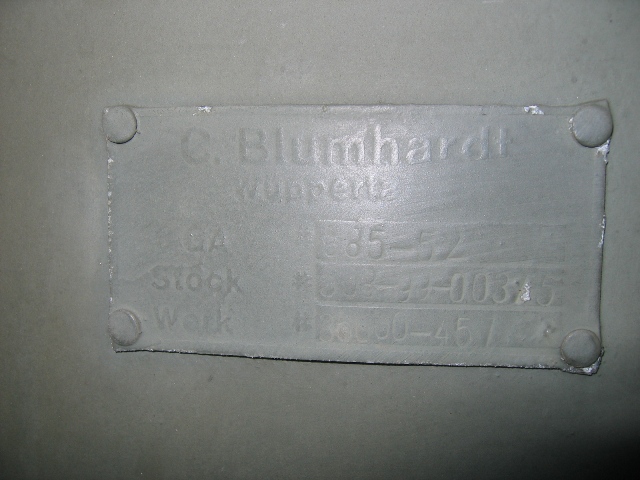
Posted: Mon Dec 31, 2007 3:44 pm
by abn CCKW
Hammerhead ....Great to see another saved and Restored CCKW ! Hope you have many years of enjoyment with it .
Posted: Mon Dec 31, 2007 5:19 pm
by Degsy
French and Norwegian built replacement bodies also had the half moon cutouts.
Posted: Mon Dec 31, 2007 6:40 pm
by Hammerhead
Chris_M
Thanks for the info and picture on the replacement bed data plate. I went out and checked mine and sure enough have no data plate nor holes where one was once. Thanks for going to the trouble to get the pictures.
Degsy
Thanks for the info that France and Norway also produced these beds post-war. Maybe mine wasn't German made; maybe that is why mine had only the half-moon cutouts on the center three stake pockets. Do you know if The Netherlands also made them?
Thanks guys
More on Post War Beds
Posted: Wed Jan 02, 2008 12:21 am
by Cat Man
I thought of one other caracteristic that is different on the original Cargo bed vs the postwar replacements.
The originals - at least the early ones also have forged type tie down hooks. The post war beds have stamped hooks spot welded on.
Here are a couple more photo's taken today that show the early hooks and the the location of the original data plate. And the field modified stake pockets. This early all steel bed was built by Edward G Budd Mfg Co. in Philadelphia PA.
A photo of a post war bed with stamped hook in the lower right is also shown for comparison.
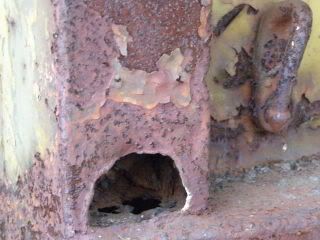
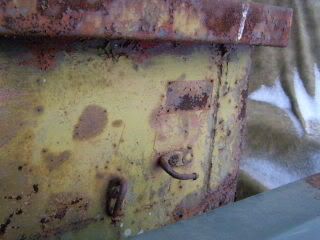
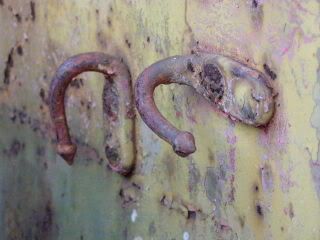

Cat Man
Posted: Tue Jan 15, 2008 11:42 pm
by Hammerhead
Hey Catman,
Thanks for the additional photos. I've got another theory about the bed on my truck!!

The forged type tie down hooks are what are on my all steel bed. That means it's a WWII production bed. It does have the half-moon cutouts on the center three stake pockets but not the end ones. So, could it be the bed on my truck is an an original early WWII one placed on this April 1944 chassis in some post-war rebuild program? If these trucks could only talk! The tales they could tell.
Thanks for all your help.
P.S. I have a book (copyright 1966) that's titled Pictorial History of the US Army. There were some great photos of "Cats" in action . If I can figure out how to get them on the forum I'll share them. There was also one of a crane mounted on a CCKW building a bridge in France 1944 which was cool looking. Karoshi....how are you putting the pictures on here?


Posted: Fri Feb 01, 2008 4:42 pm
by R Cubed
To put another spanner in the works with reference to the canvas tie down hooks on the beds, I have seen the forged ones on all steel beds but they seem to be all handed the same way so on one side of the truck they point forwards and on the other side they point backwards.
On my all steel bed it has pressed steel hooks but more oddly these are handed for the drivers side and the passenger side, on both sides the hooks point forwards and on the back tail gate and front panel they face in towards each other.
Also I have the drain cut outs in the stake pockets, seem to be very accuratly cut !! but the only pockets which dont have them are the rear ones by the tail gate but they are behind the outer sloping panel ??
I will try to do some pics and post them up.











